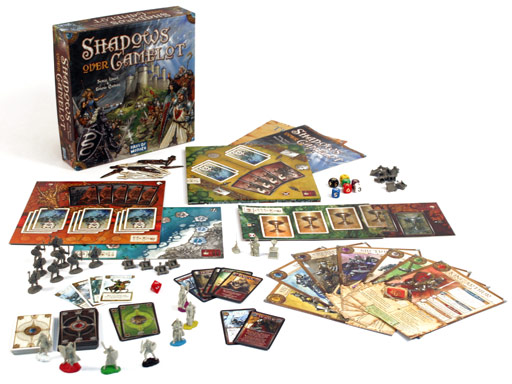It's time once again for a board game edition of Co-Op Casual Friday. Though casual video games like the LEGO series or Plants Vs. Zombies are very popular these days, there are some folks who just don't want to play them. Luckily for fans of co-op, there are plenty of excellent cooperative board games out there that are less intimidating for non-gamers. Today, we'll discuss one such game as we take a journey back to the time of King Arthur and Merlin; can you work together to overcome the Shadows Over Camelot?
I've always been a fan of the tale of King Arthur. So great is my love for the saga that I wrote a rather large paper on different interpretations of it in high school. Who could forget the Lady of the Lake, or the sword in the stone? Guinevere, or Mordred? When I learned there was a cooperative board game based on the story of King Arthur, I knew I had to have it. Shadows Over Camelot is a fine game, composed of quests that require teamwork from all the knights. However, there is a chance that one knight is working against the others, which adds a delightful tension to the entire experience.

Shadows Over Camelot supports from three to seven players, who each take on the role of a knight in the King's service. Familiar characters, such as Galahad and Gawain and of course Arthur himself, each have special abilities that aid in overcoming the spread of evil. Most powers revolve around the use of white cards, which can be played in combat, to solve quests, or to prevent evil events. For example, Gawain can draw extra cards, while the King may trade one card with another player. Good players must maximize the use of their unique abilities to defend themselves and the kingdom from the forces of darkness.
On each turn, a knight has to perform two actions; the first represents the rise of evil, and the second, the knight's own heroic efforts. Deciding which actions to take requires forethought and can literally make or break the victory. The choices for evil actions are daunting; the knight can lose a life point, draw a black card which might represent an evil calamity or could make a quest more difficult, or even choose to place an enemy catapult next to Camelot itself. When twelve such catapults are on the board, the game is over, and Camelot falls. You will literally feel as if you are stuck between a rock and a hard place when you take an evil action. Should you draw a potentially disastrous black card, or lose a valuable life point?
